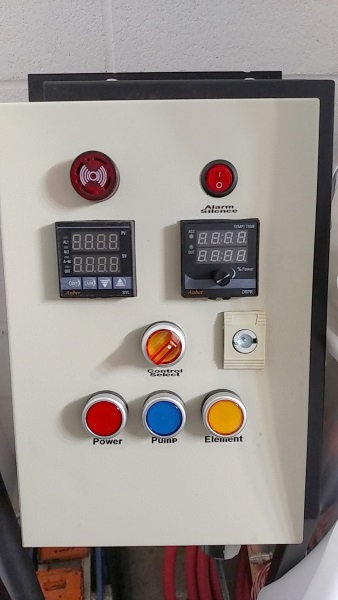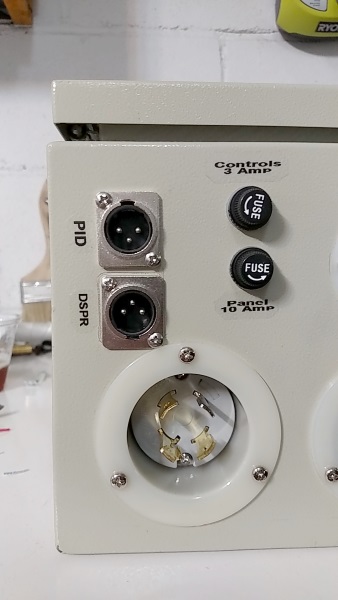Got it.
Brew on
Brew on



No, you're not missing anything, I'm just fumbling at the explanation.
My panel currently houses an Auber PID *and* a DSPR100, the original boil controller.
I thought about the temp display, but as far as I know you can't jumper a single rtd to multiple displays.
you could swap between 120 and 240 to your element
I think the settings would be quite different for the two voltages.
But I did like the idea of the PID being a passive display for CFC exit temp. I might do that one myself!
















As far as the settings, it would certainly be different, but my thought was that since you are not "tuning" the DSPR110 it may actually be able to hold a steady temperature even at the lower power output.
On my experiment the other day, the difference between an oSCr setting of 0 (the default) and -3 (the optimal for my 120V tube) was pretty drastic. I imagine you'd have to deal with either undershoot or overshoot depending on which voltage you optimized for. Or maybe find a middle setting that was good enough for both.
I don't think you can make the conclusion that required oSCr setting would need to be very different for 120V vs. 240V by only testing at 120V. It might be true, or it might not. Really need to test at both to see how the algorithm performs. The fact that it seems to hold rock steady once tuned is very encouraging. Also, tuning is much simpler than for a PID.On my experiment the other day, the difference between an oSCr setting of 0 (the default) and -3 (the optimal for my 120V tube) was pretty drastic. I imagine you'd have to deal with either undershoot or overshoot depending on which voltage you optimized for. Or maybe find a middle setting that was good enough for both.

That switch would allow the elimination of one or two contactors (depending on how some other switching was designed) for setting up a two voltage option. On the other hand, the extra contactor(s) solution lends itself to automated control, which is something I want to consider. Decisions, decisions....
Last note, I think @doug293cz had discussed a 120v option in his control panel. It would let you easily cut back the maximum power of the element without relying on the controller as much.
The most basic approach would be to use a rotary selector switch:
http://www.amazon.com/dp/B009IS7SN2/?tag=skimlinks_replacement-20
It is almost the same size as a 1/16 DIN opening, so that would be a neat fit, and you could swap between 120 and 240 to your element.

That switch would allow the elimination of one or two contactors (depending on how some other switching was designed) for setting up a two voltage option. On the other hand, the extra contactor(s) solution lends itself to automated control, which is something I want to consider. Decisions, decisions.
Brew on
It might be true, or it might not.
Hey if you want to see it running with your RIMS tube and 120V element, you can check out a video I made of it here: https://youtu.be/moM4Gg89dk8
Angrybits, it looks like it cycles on and off way faster than other systems I've seen videos of before. Can you tell us about that?

It does cycle considerably faster. The operation mode of the DSPR vs. typical PID's is described in the DSPR manual. RTFM
Brew on
Ok, thanks. I wasn't quite sure what they meant in the online description when the talk about the burst cycle being one and 100 cycles.
Are you at all worried the increased cycling will reduce the life of your SSRs?



SSR's are specifically designed for fast switching. Unless they are defective (like many counterfeit Fotek's) it won't be a problem.
Brew on
Angrybits, it looks like it cycles on and off way faster than other systems I've seen videos of before. Can you tell us about that?
It seems to do a very good job at varying the duty cycle to maintain the temperature, which as stated above should not have any impact on the life of the ssr or element.
I think it's more like a smart thermostat than anything else. While you don't see the fractional parts of the temperature, I'm quite sure that it's reacting to whether the temp is trending up or down because you see it vary the output even when the read out isn't changing. Very cool piece of gear.
Your video promises an actual mash test in the future, can't wait to see it!
So I brewed today using the DSPR110.
Out of the box, it worked like a champ. The only configuration I did was turning off the timer function and setting the offsets so that the probe measurements matched my calibrated thermometer. Came up to mash-in temps quick and smooth, no overshooting at all. Held temps rock steady, ramped quickly and smoothly between temps (Did a hochkurz type mash, 147 for 40 mins, 158 for 20 mins, 168 for 10 mins).
Only gotcha I ran into was in my original configuration, I had the temp sensor in a Tee on the kettle valve. This was no big deal, as the only time I needed to control temps the pump was running. The DSPR110 needs a temp probe in the kettle. A little disassembly of the T, drill a new hole in the kettle, a silicone washer, a stainless washer and NPT lock nut transformed my 1/2NPT RTD sensor into a weldless setup. This got me up and running.
Even if you're *not* doing single vessel, this controller kicks so much ass at mashing that I'd recommend it for a recirculating mash tun.
So I brewed today using the DSPR110.
Out of the box, it worked like a champ. The only configuration I did was turning off the timer function and setting the offsets so that the probe measurements matched my calibrated thermometer. Came up to mash-in temps quick and smooth, no overshooting at all. Held temps rock steady, ramped quickly and smoothly between temps (Did a hochkurz type mash, 147 for 40 mins, 158 for 20 mins, 168 for 10 mins).
Only gotcha I ran into was in my original configuration, I had the temp sensor in a Tee on the kettle valve. This was no big deal, as the only time I needed to control temps the pump was running. The DSPR110 needs a temp probe in the kettle. A little disassembly of the T, drill a new hole in the kettle, a silicone washer, a stainless washer and NPT lock nut transformed my 1/2NPT RTD sensor into a weldless setup. This got me up and running.
Even if you're *not* doing single vessel, this controller kicks so much ass at mashing that I'd recommend it for a recirculating mash tun.